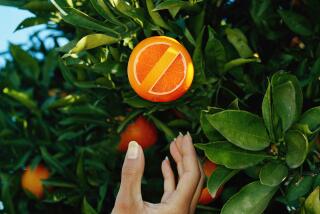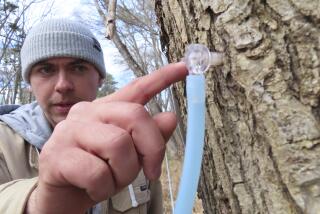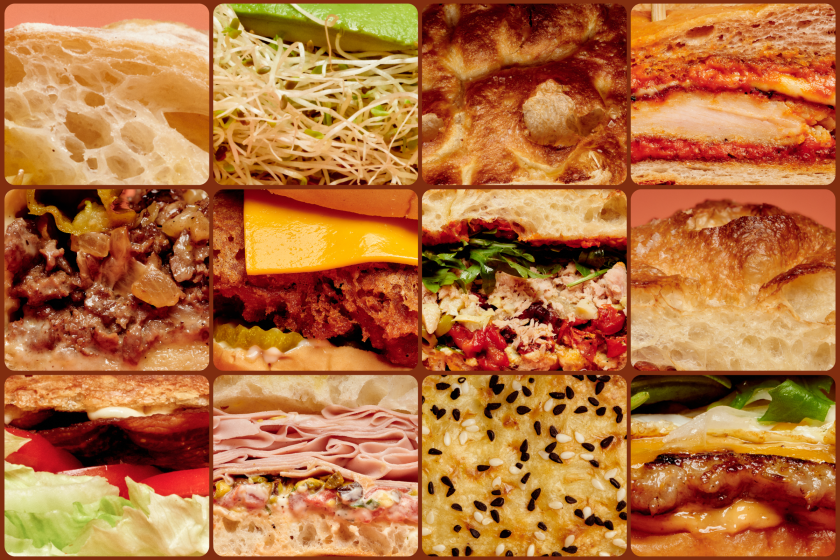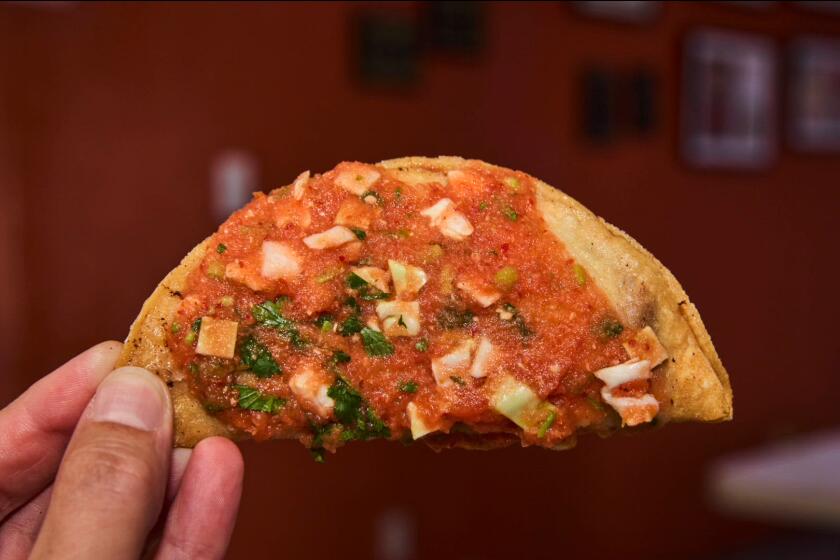If This Is Julian, Those Must Be Apples
Sure, there’s a recession and the politicians are mudslinging and the Navy is still jarred by its Tailhook, but up here in Julian, the apples are ripening right on schedule.
Don and Mary Hall are busy sizing their first harvest of Jonagold apples. Liz and Keith Smothers are gearing up to bake 1,200 pies a day at their Julian Pie Shop. Frieda Whipple at the Warm Hearth is giving her potbelly stoves a final polishing, and Joyce Birt at Fashions for You is trying to figure out where in the back room to stack some plush sweaters.
Each weekend in October is Apple Days, this 120-year-old town’s annual exercise in self-adulation. They used to mine gold up here, but now they use apples as bait to fish for tourists.
It’s the best of times for local commerce, the worst of times for year-round residents, as all those cash-packin’ lowlanders jam the streets to snag a bag of apples, a bottle of cider, a slice of pie and a piece of autumn.
So what does October mean to local business? Birt, a veteran downtown businesswoman, can only mouth the word, so as not to sound too greedy by vocalizing it:
“Money.”
She smiles.
Julian so bursts at its seams with tourists between now and Christmas that local merchants figure on making half or more of their annual take during these months.
“It’s the season that keeps everybody up here alive until the next Apple Days,” says Whipple, whose store is crammed with country-cute stuff that’s on nobody’s gotta-have list but, gee, here we are in Julian and wouldn’t this be a great Christmas gift for Aunt Mary?
“There’s just no way to prepare yourself for October,” said pie maker Smothers, her hands white from flour. “And, when it’s over, you’re on such a roll it’s hard to slow down.”
This is the time of year when no one in Julian goes for want of part-time work; the high-school kids can make enough money to pay for their prom.
Julian’s year-round population is somewhere between 500 and 3,000, depending on how you define the unincorporated town’s boundaries, but during autumn weekends it swells with out-of-towners, consuming every available parking spot and vacant lot. Tourists park along California 78 on both sides of town, trudging in as though on pilgrimage. Now they’re trying to figure out where to accommodate the tour buses that in recent years have begun to disgorge Japanese visitors.
They drive up here, to the 4,500-foot elevation, for the closest thing San Diego County has to offer in autumn chill and changing colors, for a malt at the old-fashioned, marble-topped soda fountain, and, of course, for apples.
Each Saturday and Sunday in October, about 10,000 apple pies are sold by the half-dozen or so local shops, the bakers estimate. Most of them rely on the fresh, homegrown apple supply for their fillings. Add weekday sales, and the town sells 100,000 apple pies in October alone, and some ice cream.
Indeed, the whole issue of apple pie generates some testiness in town, spilling over into the ranks of other merchants, who constantly are asked by tourists for pie recommendations.
Julian Pie Shop’s pies are a tad on the sweet side, seems the consensus, and Mom’s Pie House’s pies are a tad on the tart side. See that pie shop down the street boasting Julian’s “original” pies? That place has only been in business for a year, the townfolk chuckle under their breath.
The employees at Main Street’s Julian Cafe, which like every other eatery in town boasts the best local pie (“Voted No. 1,” one sign promotes) sheepishly admit that their pies are filled with canned apples. “Sshhh,” one waitress pleaded. At least they’re baked on the premises.
Everyone in Julian takes apples seriously. More than 600 acres around town are planted in apple orchards, a crop valued by the county at more than $500,000. Apples appreciate Julian’s frosty winters, which provide the necessary cold snap for a good crop.
Some of the early varieties are picked in late July or early August, and the harvest will continue into November. Usually dormant roadside stands--some of them mom-and-pop and some of them huge businesses--spring alive, selling every conceivable apple product from ciders and juices to jams and pies. People can even “rent” their own apple tree and pick their own fruit directly from it, and enjoy its shade for a picnic lunch.
For a small handful of growers, apples are their primary source of income--and, in a couple of cases, one that goes back a generation or two.
“I was born here. My mother was born here. I grew up in apples,” says Woody Barnes. His family-owned Manzanita Ranch at Wynola, just a couple of miles down the highway from Julian’s Main Street, is one of the mainstays.
Barnes is considered as expert as anyone in these parts about apples, and here’s his prognosis for the current harvest: “Pretty darn good.”
Barnes tends 100 acres of apples and acknowledges openly: “Some are really good and some are crummy. Some of my trees are 100 years old and should be replaced. I’ll use apples off those trees for my cider. And then I’ve got some young trees that we’ll be picking for the first time.”
That gets Barnes to talking about his new Connel Reds, a Minnesota tree that he’s planted here as an experiment, to find out how it does in Julian’s microclimate, perhaps Southern California’s best replica of New England’s four seasons.
“I don’t know anything about this tree,” he says without apology. “I saw the name in a nursery catalogue. They claim it’s a large, sweet, crisp and pretty apple. Well, that’s a fairly average description for all those apple trees in the nursery catalogues.”
Up the road 3 miles at Apple Lane Orchards, Don Hall is beaming over his first harvest of Jonagolds, a cross between Jonathans and Golden Delicious, a 3-inch-diameter fruit that’s green with a red blush. He planted 200 of the trees in 1988, and now it’s time to start cashing in.
Hall worked 35 years for General Dynamics as an electrical engineer and program manager. He and his wife, Mary, moved to Julian 15 years ago in supposed retirement and together they now work 1,200 trees planted densely on 5 acres. They’ll probably produce 300,000 apples this season, give or take a few.
“Man was put here to work, not to loaf,” he said.
Hall’s biggest customer is Mom’s Pies, and Hall said he and his wife will make enough money to pay the taxes and insurance on their property.
No one up here exports apples “off the hill,” as they like to say. No need to, what with the demand for local consumption. Indeed, when the local apple supply is depleted, the local pie shops that need fresh apples will go to conventional markets to buy their fruit.
But that isn’t to say that the fruits of Julian’s labor can’t be appreciated off the hill. Some local bakers fill mail-order requests, and Jan and Lewis LaDou, with a cottage-industry permit in hand, produce Julian Jams: a variety of apple butters, some laced with brandy or amaretto. For good measure, they produce pumpkin, pear and pomegranate butters, too.
This year, the couple expects to produce 200,000 jars of jam, most of them ending up in gift packs that are distributed to gourmet grocery stores.
Like other apple growers in town, they offer apple trees for rent, from $50 to $85 per year, depending on the tree’s size and guaranteed yield. Apple devotees can drive up any weekend to pick their own fruit and drink in the season.
Like a beachfront dweller who relishes the retreat of inland tourists, Lewis LaDou says Julian’s Apple Days are a bittersweet experience. “It’s a little inconvenient for the people who live up here,” he said. “But it’s nice to see the merchants do well.
“It’s hard to keep agriculture alive in San Diego County, or in all of California for that matter. We’re proud of our orchards--and the fact that they haven’t been turned into subdivisions.”
More to Read
Eat your way across L.A.
Get our weekly Tasting Notes newsletter for reviews, news and more.
You may occasionally receive promotional content from the Los Angeles Times.










